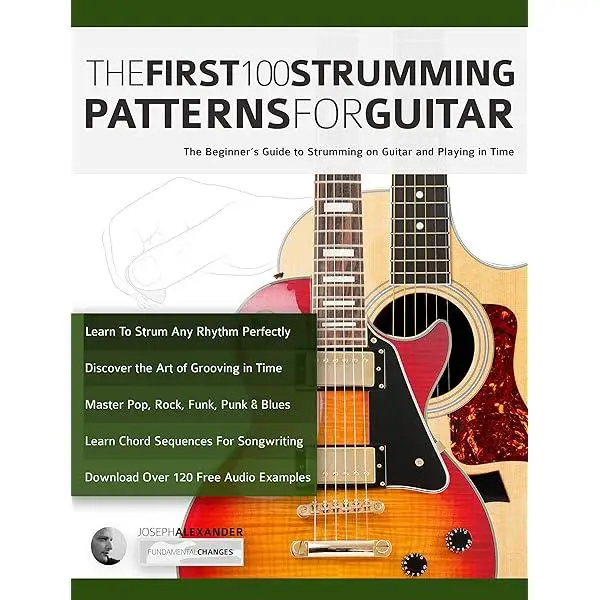Are you tired of strumming your acoustic guitar like a confused chicken stumbling through a barnyard? Fear not, dear reader, for we have crafted the ultimate guide to acoustic guitar strumming patterns that will turn you from an awkward guitarist into a strumming sensation. Get ready to serenade your friends, family, and maybe even a few unsuspecting woodland creatures with your newfound rhythmic prowess. Let’s dive into the magical world of strumming and unleash your inner guitar god (or goddess)!
Contents
- 1 Understanding the Basics of Acoustic Guitar Strumming
- 2 Exploring Fundamental Strumming Patterns
- 3 Advanced Strumming Techniques for Acoustic Guitar
- 4 The Role of Hand Position and Strumming Dynamics
- 5 Incorporating Muted Strums and Percussive Hits
- 6 Transitioning Smoothly Between Strumming Patterns
- 7 Essential Practice Tips for Mastering Strumming on Acoustic Guitar
- 8 FAQs
- 9 Strumming Along
Understanding the Basics of Acoustic Guitar Strumming
So, you’ve picked up an acoustic guitar and you’re ready to strum your way to stardom! But before you start channeling your inner rock god, it’s important to understand the basics of acoustic guitar strumming. Here are a few tips to get you started on the right chord…I mean, track:
First things first, let’s talk about your strumming hand. It’s not just there to look pretty – it’s the driving force behind your sound. So, make sure to keep a loose grip on your pick (unless you’re going for that death metal sound, in which case, hold on for dear life). Remember, the pick is your friend, not your enemy. Treat it with respect and it will reward you with beautiful melodies.
Now, onto the actual strumming technique. The key here is to keep a steady rhythm. Don’t be afraid to tap your foot or bob your head along with the beat. And remember, practice makes perfect. Start slow and gradually increase your speed as you get more comfortable. Before you know it, you’ll be strumming like a pro.
Another important tip is to experiment with different strumming patterns. Don’t be afraid to get creative! Mix it up with some downstrokes, upstrokes, and even a little palm muting for good measure. The world is your oyster…or should I say, your guitar pick.

Exploring Fundamental Strumming Patterns
Let’s dive into the wacky world of fundamental strumming patterns! Whether you’re a beginner or a seasoned pro, mastering these basic patterns is essential for any aspiring guitarist. So grab your trusty six-string and let’s get strumming!
First up, we have the classic down-up strum. This simple yet effective pattern involves strumming downward on the strings, then quickly following up with an upward strum. Repeat this motion in a steady rhythm, and before you know it, you’ll be strumming like a rockstar!
Next, we have the all-powerful down-down-up-up pattern. This funky rhythm involves strumming downward twice, followed by an upward strum, and then another upward strum. It may sound confusing at first, but with a little practice, you’ll be grooving to the beat in no time!
And last but not least, we have the ever-popular down-down-down-up strum. This pattern is perfect for adding some flair to your playing, as it involves three downward strums followed by an upward strum. Get ready to impress your friends with this catchy groove!

Advanced Strumming Techniques for Acoustic Guitar
So, you’ve mastered the basics of strumming on your acoustic guitar and now you’re ready to take your skills to the next level. Well, you’ve come to the right place! Here are some advanced strumming techniques that will have you sounding like a rock star in no time.
First up, we have the palm muting technique. This is where you lightly rest the side of your picking hand on the strings near the bridge of the guitar. It gives a muted, percussive sound that can add a lot of groove to your playing. Try using this technique in combination with regular strumming for a cool contrast in dynamics.
Next, let’s talk about upstrokes. Most beginners focus on downstrokes when strumming, but incorporating upstrokes can really spice up your playing. Experiment with different patterns and rhythms using both downstrokes and upstrokes to create a more dynamic sound.
Another fun technique to try is harmonic strumming. This involves lightly touching the strings at certain points along the fretboard while strumming to produce a bell-like, ethereal sound. It takes some practice to find the sweet spots for harmonics, but once you do, you’ll be amazed at the beautiful tones you can create.

The Role of Hand Position and Strumming Dynamics
So you’ve picked up a guitar and are ready to rock out like a true superstar. But wait, before you start shredding those strings, let’s talk about the importance of hand position and strumming dynamics. Trust me, it’s not just about looking cool, although that’s definitely a bonus.
First things first, your hand position. Imagine your hand is a majestic eagle soaring through the sky, gracefully gliding over the strings. Don’t let it flop around like a fish out of water. Keep your wrist straight and your fingers poised, ready to strike those chords with precision. It’s all about finesse, baby.
Now, onto strumming dynamics. Ah, the secret sauce that separates the amateurs from the pros. Think of it like a rollercoaster – sometimes you want a gentle slope, other times you want to hit those loops and twists at full speed. Play around with your strumming patterns, experiment with different rhythms, and most importantly, feel the music in your soul. That’s where the magic happens.
Remember, hand position and strumming dynamics are the foundation of your guitar playing journey. Don’t rush it – take your time, practice regularly, and soon enough, you’ll be strumming and picking like a true rock god. Now go forth, young grasshopper, and unleash your musical prowess upon the world!

Incorporating Muted Strums and Percussive Hits
Bored of the same old strumming patterns on your guitar? Want to spice up your playing with some muted strums and percussive hits? Well, you’ve come to the right place! Incorporating these techniques into your playing can take your sound to a whole new level.
First off, let’s talk about muted strums. By lightly resting your fretting hand across the strings as you strum, you can create a tight, percussive sound that adds texture to your playing. Try experimenting with different placements of your hand to vary the muted effect and create a unique rhythm.
Next, let’s dive into percussive hits. Adding subtle taps or slaps to your playing can give it a percussive edge that will make your audience sit up and take notice. Play around with different parts of your guitar – the body, the neck, even the strings themselves – to see what kind of sounds you can create.
So go ahead, incorporate muted strums and percussive hits into your playing and watch as your music takes on a whole new dimension. Who knows, you might just discover your new signature sound!
Transitioning Smoothly Between Strumming Patterns
So you’ve mastered a few strumming patterns and now you’re ready to take your guitar playing to the next level. can be tricky, but fear not – with a bit of practice and some helpful tips, you’ll be switching between patterns like a pro in no time!
One key to seamlessly transitioning between strumming patterns is to focus on your wrist movement. Make sure to keep a relaxed grip on your pick and allow your wrist to flow naturally as you switch between patterns. This will help you maintain a smooth and consistent rhythm throughout your playing.
Another helpful tip is to practice transitioning between patterns slowly at first. Start off by playing each pattern individually, then gradually increase the tempo as you become more comfortable. This will help you build muscle memory and train your brain to anticipate the changes in rhythm.
Remember, practice makes perfect! The more time you spend honing your skills and experimenting with different strumming patterns, the easier it will become to transition between them seamlessly. So grab your guitar, crank up your favorite tunes, and get ready to rock out with your new strumming skills!
Essential Practice Tips for Mastering Strumming on Acoustic Guitar
So you’ve picked up the acoustic guitar and you’re ready to strum your way to greatness! Here are some essential practice tips to help you master the art of strumming:
- Make sure you’re holding the guitar properly – no, it’s not a table you can rest your coffee mug on.
- Practice your downstrokes with precision – imagine you’re smacking a mosquito on a hot summer day.
- Don’t forget about those upstrokes – it’s like you’re giving the guitar a little tickle.
Remember, rhythm is key when it comes to strumming. You don’t want to sound like a drunk drummer trying to keep up with a fast-paced track. Find your groove and stick to it like glue.
Lastly, don’t be afraid to experiment with different strumming patterns. Who knows, you might stumble upon a new technique that could turn you into the next guitar hero. Keep strumming, keep practicing, and most importantly, have fun!
FAQs
Why do I need to learn different strumming patterns for acoustic guitar?
Because using the same strumming pattern for every song is like wearing the same outfit to every event – boring and not very versatile. Different strumming patterns can add variety, dynamics, and overall pizzazz to your playing.
How can I improve my rhythm and timing when learning strumming patterns?
Practice, practice, practice! Tap your foot to keep the beat, play along with a metronome, and don’t be afraid to start slow and gradually increase speed as you get more comfortable. And remember, it’s okay to make mistakes – even the pros mess up sometimes.
Is it essential to memorize a bunch of strumming patterns, or can I just wing it?
It’s like cooking without a recipe – sure, you can try to wing it, but having a few solid recipes in your arsenal will definitely help you whip up some musical magic. Start with a few basic patterns and then let your creativity take over.
How can I spice up my strumming patterns to make them more interesting?
Add some embellishments like muted strums, percussive hits, or even fingerpicking elements to keep things fresh. You can also experiment with different dynamics, accents, and syncopation to add some flavor to your playing.
Are there any resources or tools that can help me learn new strumming patterns?
YouTube tutorials, online guitar courses, and good old-fashioned jam sessions with other musicians can all be great ways to expand your strumming repertoire. And don’t forget to listen to your favorite songs and try to mimic the strumming patterns – imitation is the sincerest form of flattery, after all.
Strumming Along
Well, dear reader, we have reached the end of our journey through the wonderful world of acoustic guitar strumming patterns. I hope you’ve enjoyed learning all about the ins and outs of creating unique rhythms and styles with your trusty six-string companion.
Remember, practice makes perfect, so don’t be afraid to experiment and try out new patterns to find your own signature sound. Keep strumming, keep rocking, and most importantly, keep having fun making beautiful music with your acoustic guitar. Until next time, happy strumming!



